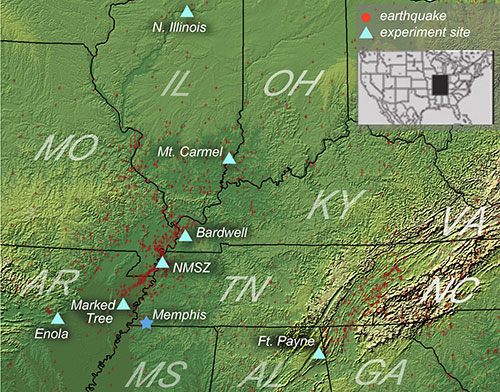The Working Group on Data Conversion (WGDC)
The Working Group on Data Conversion (WGDC) project converts seismic data from PASSCAL and non-PASSCAL experiments as well as aftershock surveys from 1987 to 2011 into a seismic data base. Our responsibility is to:
- develop software/hardware protocols for efficient conversion of the CERI legacy and field deployment datasets into community readable seismic databases,
- prepare the Experiments Data into a fully compliant IRIS SEED volume to submit to the Data Management Center (DMC) for archiving, and to
- identify existing datasets for conversion
Nineteen digital data sets are identified and selected. A network code is first assigned by the IRIS-DMC. The Antelope software package is then used to build the database for each experiment.
Each experiment requires:
- Network code and short description for each deployment;
- Deployment on/off time;
- Station latitude / longitude in degree, elevation (km), and short description;
- Types of sensor and datalogger, and station's serial numbers;
- Sampling rate;
- Data channel designation; and
- Waveform data in full miniseed format with big endian.
All data must be compiled into a complete SEED volumes and a dataless metadata, the PASSCAL data sets - submitted via "python send2passcal.py" to the New Mexico PASSCAL data center.
Others (invited non-PASSCAL experiments and aftershock surveys) - submitted to the DMC for archiving via "ms2dmc", and added to "CERI's Temporary Virtual Network".
Forensic investigations are needed for the datasets. Due to the availability and quality of field notes, time estimation required for building each dataset into a database can vary significantly. And construction of associated metadata can be time-consuming due to instrumentation types (sensor, datalogger and response), wave component designation, station name/location, converting waveform name into a human-readable event filename, and re-grouping into smaller data sets for large volume recordings (due to the limited memory of the software in the antelope package).

The map above shows the detailed locations of experiment sites conducted in the central and eastern United States. Triangles represent individual experiment sites deployed in the central and eastern USA.
The experiments were in the following regions (corresponding data sets are found in the side bar to your right):
- San Juan, Argentina
- Central New Madrid Seismic Zone
- Hawaii
- North Island, New Zealand
- Gujarat, India
- ESEE (southern and central New Madrid Seismic Zone)
- Ft. Payne, Alabama
- Bardwell, Kentucky
- Enola, Arkansas
- Northern Illinois
- Mt. Carmel, Illinois
